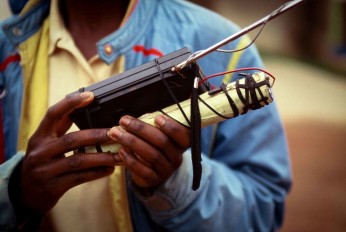By: Matt Schmitt,
Nearly twenty-two years ago, the world watched as Rwanda descended into the bloodiest conflict of the late 20th century. The ensuing genocide included the killing of roughly 800,000 Tutsis and news from the crisis was aired all over the world.[1] By late summer 1994, the country had fallen into ruin and the seeds had been sewn for the much more devastating Second Congo War, a conflict that would result in the deaths of millions more. From the genocide’s onset, Radio Télévision Libre des Mille Collines (RTLMC), Rwanda’s Hutu-backed radio station, broadcasted genocide-inciting propaganda and assisted Interahamwe killers in locating victims hidden within the country.[2] Throughout the international community, human rights groups advocated for the jamming of the RTLMC frequency so that communication between death squads would be cut.[3] No United Nations member state, however, including the United States, took such steps and the broadcasts continued throughout the summer, securing the station’s role as a “central feature” of the “highly systematic and synchronized” massacres that occurred.[4]
The biggest roadblock to Western intervention concerning the jamming of RTLMC came in the form of international law, namely whether or not it was legal. The United States government deemed that such activities would violate Rwanda’s freedom of expression[5] and intrude upon their state sovereignty.[6] This legal reasoning does hold some water, especially when applied to the politics of the Cold War, however, the humanitarian law concerning the broadcasts is much more strongly defined. It states that each U.N. member state has the responsibility to protect the populations of the world “from genocide, war crimes, ethnic cleansing and crimes against humanity,” which includes “prevention of such crimes, including their incitement, through appropriate and necessary means.”[7]
The fact that RTLMC continued to broadcast throughout the genocide, unhindered by any United Nations member state, suggesting that deeper political issues discouraged their involvement. First, adequately disabling the hate radio transmissions of the génocidaires would require either to fly an airborne platform over the country day and night, which would be exorbitantly expensive, or to send in numerous teams of well-trained personnel with jamming equipment.[8] The summer of 1994, however, was no time to try and convince a Western country to send troops into a small African country due to the crisis in Mogadishu, Somalia the previous October, in which eighteen American soldiers had lost their lives.[9] The United Nations, especially the United States government, felt that it was simply not worth the risk to make attempts in shutting down the radio, making it clear that widespread humanitarian abuses are “considered secondary to concerns about the political and monetary costs.”[10]
Should laws governing the technological sovereignty and freedoms to express shield a country from the intervention of other world powers in order to deter flagrant human rights violations? The crisis that occurred in Rwanda in 1994 seems to illustrate the strength of international humanitarian law in preventing mass violence and its insurmountable failure in preventing the incitement of genocide, bowing down to the political process rather then relying on the principle that “human rights should be protected by the rule of law.”[11]
[1] Jaime F. Metzl, Rwandan Genocide and the International Law of Radio Jamming, 91 Am. J. Int’l L. 628, 629 (1997).
[2] Allan Thompson, The Media and the Rwanda Genocide 41, 47 (Pluto Press 2007).
[3] Jaime F. Metzl, Rwandan Genocide and the International Law of Radio Jamming, 91 Am. J. Int’l L. 628, 633 (1997).
[4] Id. 630.
[5] U.N. Charter art. 76, para. 1.
[6] U.N. Charter art. 2, para. 1.
[7] 2005 World Summit Outcome, G.A. Res. 60/1, U.N. Doc. A/RES/60/1 (Oct. 24, 2005).
[8] Jaime F. Metzl, Rwandan Genocide and the International Law of Radio Jamming, 91 Am. J. Int’l L. 628, 635 (1997).
[9] Ranger Recalls ‘Insane,’ Deadly Somalia Mission, CNN (Oct. 27, 2001) available at http://www.cnn.com/2001/US/10/27/ret.thomas.somalia.cnna/.
[10] Jaime F. Metzl, Rwandan Genocide and the International Law of Radio Jamming, 91 Am. J. Int’l L. 628, 635 (1997).
[11] Universal Declaration of Human Rights, G.A. Res. 217 (III) A, U.N. Doc. A/RES/217OII) (Dec. 10,1948).
photo source.
http://cache.20minutes.fr/photos/2014/04/11/rwanda-zone-turquoise-gikongoro-juillet-0848-diaporama.jpg

